CIS5100: Professional Skills for E-Business Migration - Dr. Little
VerifiedAdded on 2023/06/07
|29
|7600
|63
Report
AI Summary
This report analyzes the challenges, benefits, and equipment needed for Dr. Little's business to migrate to e-business. Key considerations include content management systems, e-business and marketing measurement tools, cloud connectivity, knowledge management systems, and Ethernet and internet connectivity. The report also highlights the importance of global collaboration, potential risks associated with e-business technology, and recommends B2B and B2C models for increased awareness, better communication, and improved service. E-business tools such as CRM, email marketing automation, and community support are discussed, emphasizing their role in connecting with clients and enhancing business growth. The study emphasizes the need for businesses to equip themselves with advanced solutions to stand out in the competitive e-commerce landscape.
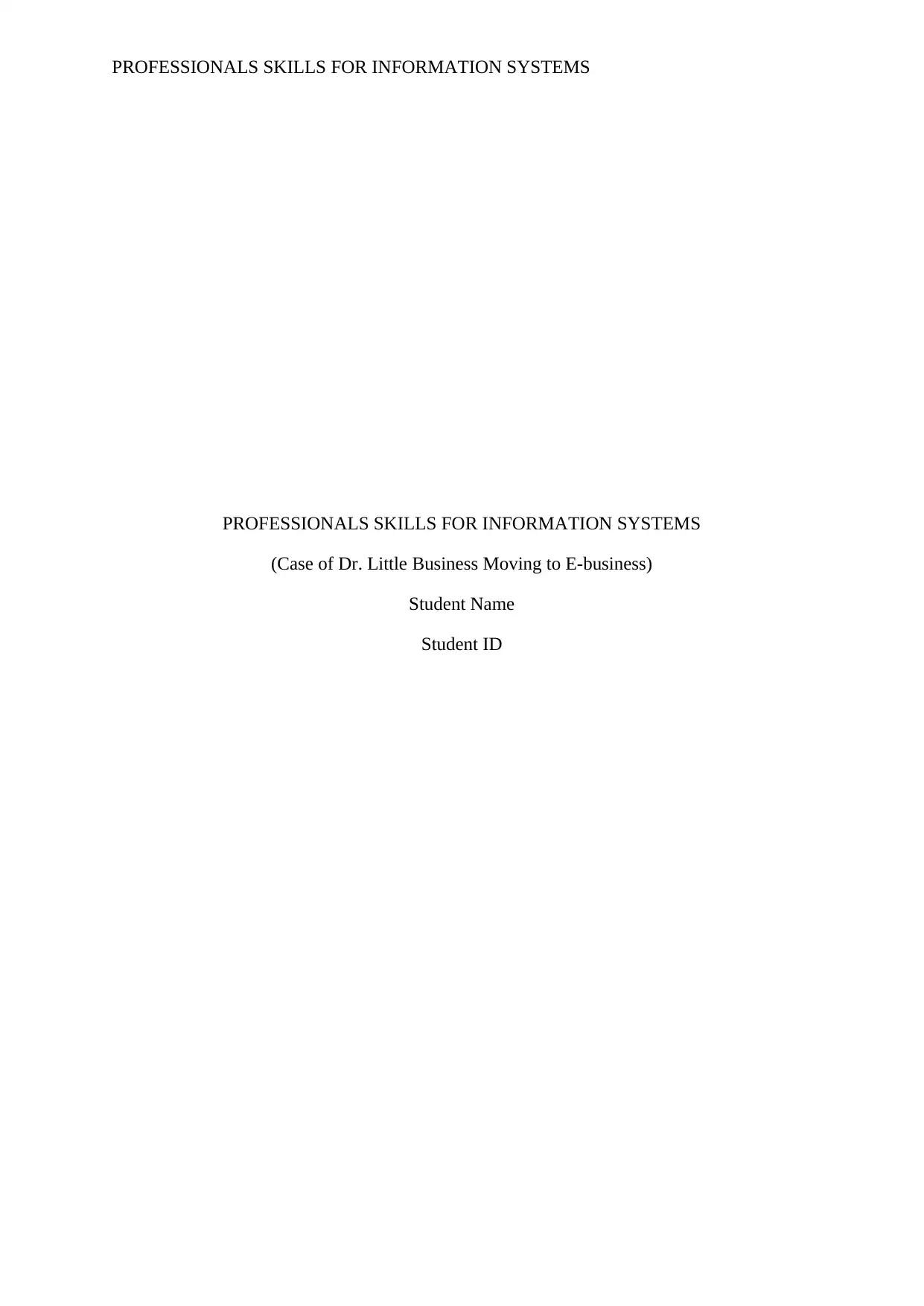
PROFESSIONALS SKILLS FOR INFORMATION SYSTEMS
PROFESSIONALS SKILLS FOR INFORMATION SYSTEMS
(Case of Dr. Little Business Moving to E-business)
Student Name
Student ID
PROFESSIONALS SKILLS FOR INFORMATION SYSTEMS
(Case of Dr. Little Business Moving to E-business)
Student Name
Student ID
Paraphrase This Document
Need a fresh take? Get an instant paraphrase of this document with our AI Paraphraser

PROFESSIONALS SKILLS FOR INFORMATION SYSTEMS
EXECUTIVE SUMMARY
The report demonstrates and summarizes the challenges, benefits, needed equipment
including software and hardware systems. The important steps considered before migrating to
an e-business include content management system, e-business and marketing measurement
tools, cloud connectivity, knowledge management systems, and Ethernet and internet
connectivity. Besides, global collaboration and its importance is demonstrated and risks
connected to e-business technology.
EXECUTIVE SUMMARY
The report demonstrates and summarizes the challenges, benefits, needed equipment
including software and hardware systems. The important steps considered before migrating to
an e-business include content management system, e-business and marketing measurement
tools, cloud connectivity, knowledge management systems, and Ethernet and internet
connectivity. Besides, global collaboration and its importance is demonstrated and risks
connected to e-business technology.
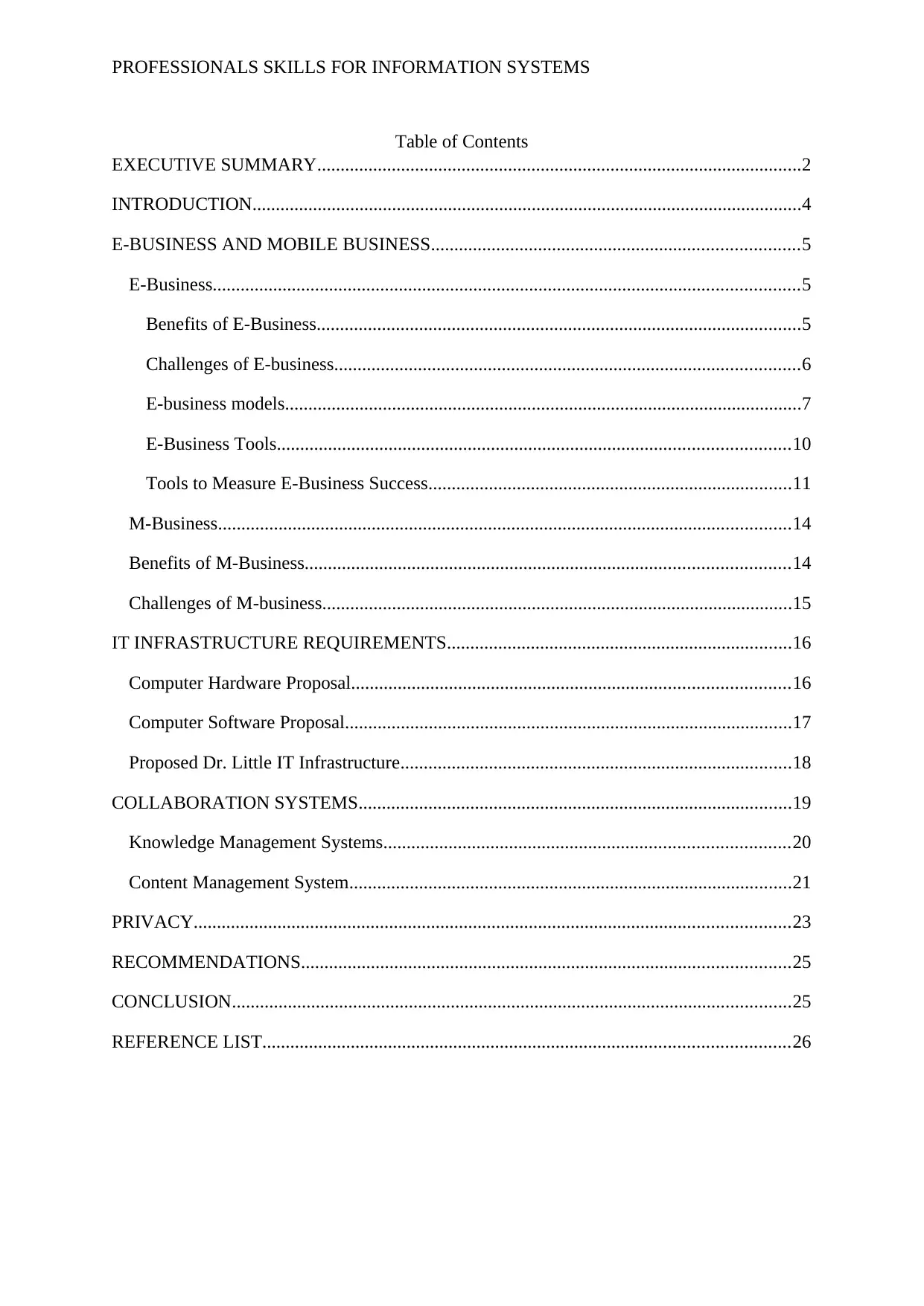
PROFESSIONALS SKILLS FOR INFORMATION SYSTEMS
Table of Contents
EXECUTIVE SUMMARY........................................................................................................2
INTRODUCTION......................................................................................................................4
E-BUSINESS AND MOBILE BUSINESS...............................................................................5
E-Business..............................................................................................................................5
Benefits of E-Business........................................................................................................5
Challenges of E-business....................................................................................................6
E-business models...............................................................................................................7
E-Business Tools..............................................................................................................10
Tools to Measure E-Business Success..............................................................................11
M-Business...........................................................................................................................14
Benefits of M-Business........................................................................................................14
Challenges of M-business.....................................................................................................15
IT INFRASTRUCTURE REQUIREMENTS..........................................................................16
Computer Hardware Proposal..............................................................................................16
Computer Software Proposal................................................................................................17
Proposed Dr. Little IT Infrastructure....................................................................................18
COLLABORATION SYSTEMS.............................................................................................19
Knowledge Management Systems.......................................................................................20
Content Management System...............................................................................................21
PRIVACY................................................................................................................................23
RECOMMENDATIONS.........................................................................................................25
CONCLUSION........................................................................................................................25
REFERENCE LIST.................................................................................................................26
Table of Contents
EXECUTIVE SUMMARY........................................................................................................2
INTRODUCTION......................................................................................................................4
E-BUSINESS AND MOBILE BUSINESS...............................................................................5
E-Business..............................................................................................................................5
Benefits of E-Business........................................................................................................5
Challenges of E-business....................................................................................................6
E-business models...............................................................................................................7
E-Business Tools..............................................................................................................10
Tools to Measure E-Business Success..............................................................................11
M-Business...........................................................................................................................14
Benefits of M-Business........................................................................................................14
Challenges of M-business.....................................................................................................15
IT INFRASTRUCTURE REQUIREMENTS..........................................................................16
Computer Hardware Proposal..............................................................................................16
Computer Software Proposal................................................................................................17
Proposed Dr. Little IT Infrastructure....................................................................................18
COLLABORATION SYSTEMS.............................................................................................19
Knowledge Management Systems.......................................................................................20
Content Management System...............................................................................................21
PRIVACY................................................................................................................................23
RECOMMENDATIONS.........................................................................................................25
CONCLUSION........................................................................................................................25
REFERENCE LIST.................................................................................................................26
⊘ This is a preview!⊘
Do you want full access?
Subscribe today to unlock all pages.

Trusted by 1+ million students worldwide
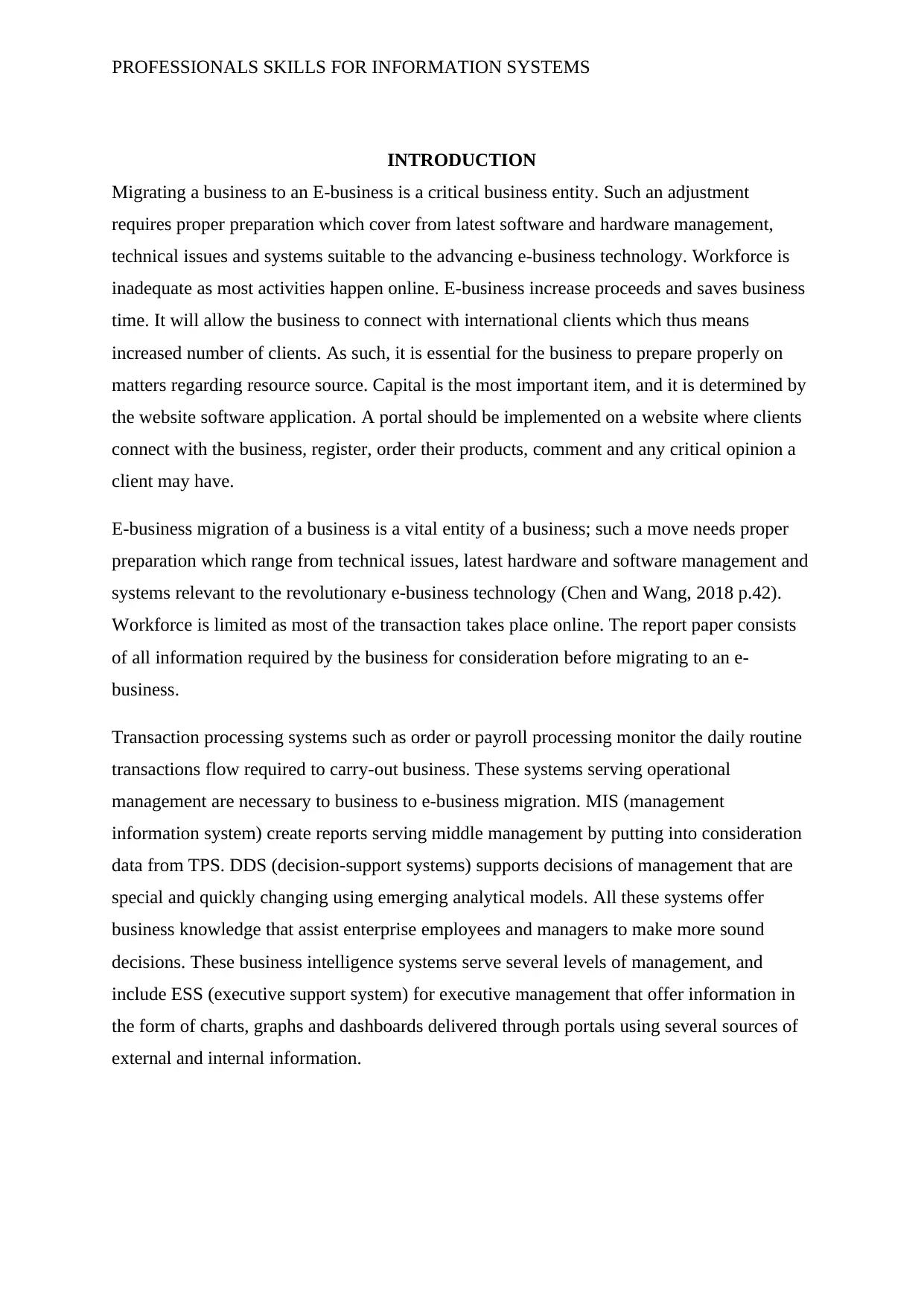
PROFESSIONALS SKILLS FOR INFORMATION SYSTEMS
INTRODUCTION
Migrating a business to an E-business is a critical business entity. Such an adjustment
requires proper preparation which cover from latest software and hardware management,
technical issues and systems suitable to the advancing e-business technology. Workforce is
inadequate as most activities happen online. E-business increase proceeds and saves business
time. It will allow the business to connect with international clients which thus means
increased number of clients. As such, it is essential for the business to prepare properly on
matters regarding resource source. Capital is the most important item, and it is determined by
the website software application. A portal should be implemented on a website where clients
connect with the business, register, order their products, comment and any critical opinion a
client may have.
E-business migration of a business is a vital entity of a business; such a move needs proper
preparation which range from technical issues, latest hardware and software management and
systems relevant to the revolutionary e-business technology (Chen and Wang, 2018 p.42).
Workforce is limited as most of the transaction takes place online. The report paper consists
of all information required by the business for consideration before migrating to an e-
business.
Transaction processing systems such as order or payroll processing monitor the daily routine
transactions flow required to carry-out business. These systems serving operational
management are necessary to business to e-business migration. MIS (management
information system) create reports serving middle management by putting into consideration
data from TPS. DDS (decision-support systems) supports decisions of management that are
special and quickly changing using emerging analytical models. All these systems offer
business knowledge that assist enterprise employees and managers to make more sound
decisions. These business intelligence systems serve several levels of management, and
include ESS (executive support system) for executive management that offer information in
the form of charts, graphs and dashboards delivered through portals using several sources of
external and internal information.
INTRODUCTION
Migrating a business to an E-business is a critical business entity. Such an adjustment
requires proper preparation which cover from latest software and hardware management,
technical issues and systems suitable to the advancing e-business technology. Workforce is
inadequate as most activities happen online. E-business increase proceeds and saves business
time. It will allow the business to connect with international clients which thus means
increased number of clients. As such, it is essential for the business to prepare properly on
matters regarding resource source. Capital is the most important item, and it is determined by
the website software application. A portal should be implemented on a website where clients
connect with the business, register, order their products, comment and any critical opinion a
client may have.
E-business migration of a business is a vital entity of a business; such a move needs proper
preparation which range from technical issues, latest hardware and software management and
systems relevant to the revolutionary e-business technology (Chen and Wang, 2018 p.42).
Workforce is limited as most of the transaction takes place online. The report paper consists
of all information required by the business for consideration before migrating to an e-
business.
Transaction processing systems such as order or payroll processing monitor the daily routine
transactions flow required to carry-out business. These systems serving operational
management are necessary to business to e-business migration. MIS (management
information system) create reports serving middle management by putting into consideration
data from TPS. DDS (decision-support systems) supports decisions of management that are
special and quickly changing using emerging analytical models. All these systems offer
business knowledge that assist enterprise employees and managers to make more sound
decisions. These business intelligence systems serve several levels of management, and
include ESS (executive support system) for executive management that offer information in
the form of charts, graphs and dashboards delivered through portals using several sources of
external and internal information.
Paraphrase This Document
Need a fresh take? Get an instant paraphrase of this document with our AI Paraphraser
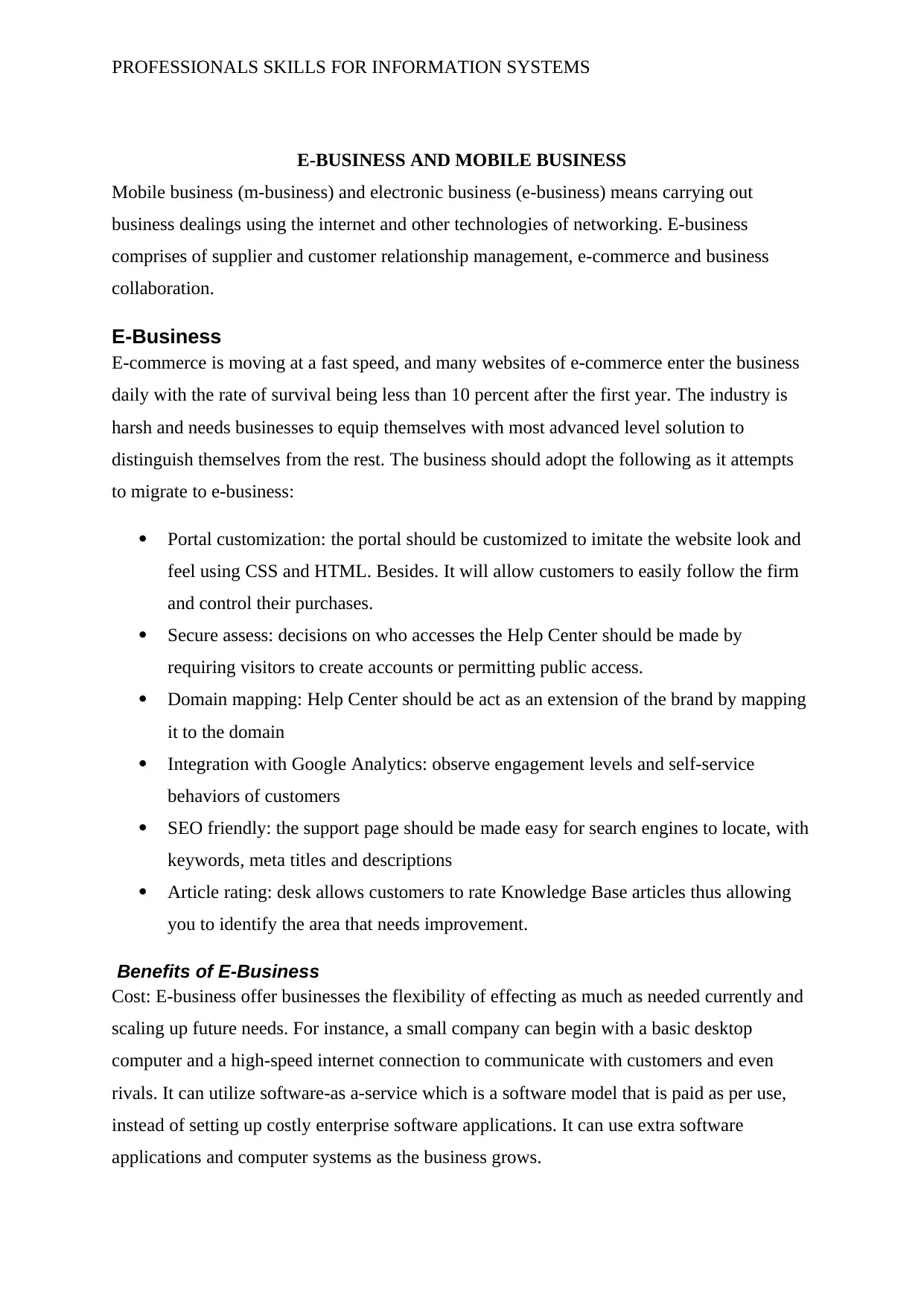
PROFESSIONALS SKILLS FOR INFORMATION SYSTEMS
E-BUSINESS AND MOBILE BUSINESS
Mobile business (m-business) and electronic business (e-business) means carrying out
business dealings using the internet and other technologies of networking. E-business
comprises of supplier and customer relationship management, e-commerce and business
collaboration.
E-Business
E-commerce is moving at a fast speed, and many websites of e-commerce enter the business
daily with the rate of survival being less than 10 percent after the first year. The industry is
harsh and needs businesses to equip themselves with most advanced level solution to
distinguish themselves from the rest. The business should adopt the following as it attempts
to migrate to e-business:
Portal customization: the portal should be customized to imitate the website look and
feel using CSS and HTML. Besides. It will allow customers to easily follow the firm
and control their purchases.
Secure assess: decisions on who accesses the Help Center should be made by
requiring visitors to create accounts or permitting public access.
Domain mapping: Help Center should be act as an extension of the brand by mapping
it to the domain
Integration with Google Analytics: observe engagement levels and self-service
behaviors of customers
SEO friendly: the support page should be made easy for search engines to locate, with
keywords, meta titles and descriptions
Article rating: desk allows customers to rate Knowledge Base articles thus allowing
you to identify the area that needs improvement.
Benefits of E-Business
Cost: E-business offer businesses the flexibility of effecting as much as needed currently and
scaling up future needs. For instance, a small company can begin with a basic desktop
computer and a high-speed internet connection to communicate with customers and even
rivals. It can utilize software-as a-service which is a software model that is paid as per use,
instead of setting up costly enterprise software applications. It can use extra software
applications and computer systems as the business grows.
E-BUSINESS AND MOBILE BUSINESS
Mobile business (m-business) and electronic business (e-business) means carrying out
business dealings using the internet and other technologies of networking. E-business
comprises of supplier and customer relationship management, e-commerce and business
collaboration.
E-Business
E-commerce is moving at a fast speed, and many websites of e-commerce enter the business
daily with the rate of survival being less than 10 percent after the first year. The industry is
harsh and needs businesses to equip themselves with most advanced level solution to
distinguish themselves from the rest. The business should adopt the following as it attempts
to migrate to e-business:
Portal customization: the portal should be customized to imitate the website look and
feel using CSS and HTML. Besides. It will allow customers to easily follow the firm
and control their purchases.
Secure assess: decisions on who accesses the Help Center should be made by
requiring visitors to create accounts or permitting public access.
Domain mapping: Help Center should be act as an extension of the brand by mapping
it to the domain
Integration with Google Analytics: observe engagement levels and self-service
behaviors of customers
SEO friendly: the support page should be made easy for search engines to locate, with
keywords, meta titles and descriptions
Article rating: desk allows customers to rate Knowledge Base articles thus allowing
you to identify the area that needs improvement.
Benefits of E-Business
Cost: E-business offer businesses the flexibility of effecting as much as needed currently and
scaling up future needs. For instance, a small company can begin with a basic desktop
computer and a high-speed internet connection to communicate with customers and even
rivals. It can utilize software-as a-service which is a software model that is paid as per use,
instead of setting up costly enterprise software applications. It can use extra software
applications and computer systems as the business grows.
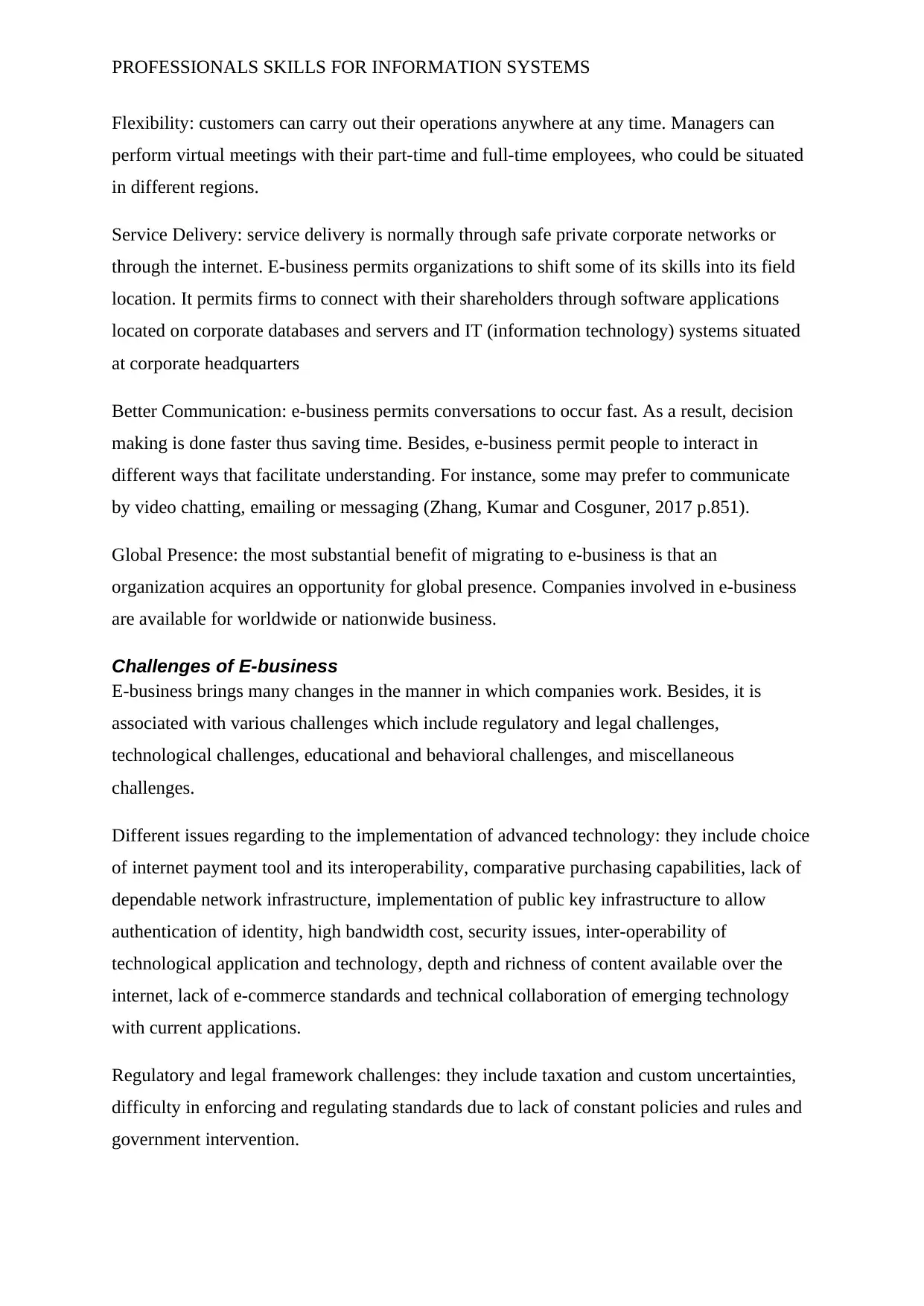
PROFESSIONALS SKILLS FOR INFORMATION SYSTEMS
Flexibility: customers can carry out their operations anywhere at any time. Managers can
perform virtual meetings with their part-time and full-time employees, who could be situated
in different regions.
Service Delivery: service delivery is normally through safe private corporate networks or
through the internet. E-business permits organizations to shift some of its skills into its field
location. It permits firms to connect with their shareholders through software applications
located on corporate databases and servers and IT (information technology) systems situated
at corporate headquarters
Better Communication: e-business permits conversations to occur fast. As a result, decision
making is done faster thus saving time. Besides, e-business permit people to interact in
different ways that facilitate understanding. For instance, some may prefer to communicate
by video chatting, emailing or messaging (Zhang, Kumar and Cosguner, 2017 p.851).
Global Presence: the most substantial benefit of migrating to e-business is that an
organization acquires an opportunity for global presence. Companies involved in e-business
are available for worldwide or nationwide business.
Challenges of E-business
E-business brings many changes in the manner in which companies work. Besides, it is
associated with various challenges which include regulatory and legal challenges,
technological challenges, educational and behavioral challenges, and miscellaneous
challenges.
Different issues regarding to the implementation of advanced technology: they include choice
of internet payment tool and its interoperability, comparative purchasing capabilities, lack of
dependable network infrastructure, implementation of public key infrastructure to allow
authentication of identity, high bandwidth cost, security issues, inter-operability of
technological application and technology, depth and richness of content available over the
internet, lack of e-commerce standards and technical collaboration of emerging technology
with current applications.
Regulatory and legal framework challenges: they include taxation and custom uncertainties,
difficulty in enforcing and regulating standards due to lack of constant policies and rules and
government intervention.
Flexibility: customers can carry out their operations anywhere at any time. Managers can
perform virtual meetings with their part-time and full-time employees, who could be situated
in different regions.
Service Delivery: service delivery is normally through safe private corporate networks or
through the internet. E-business permits organizations to shift some of its skills into its field
location. It permits firms to connect with their shareholders through software applications
located on corporate databases and servers and IT (information technology) systems situated
at corporate headquarters
Better Communication: e-business permits conversations to occur fast. As a result, decision
making is done faster thus saving time. Besides, e-business permit people to interact in
different ways that facilitate understanding. For instance, some may prefer to communicate
by video chatting, emailing or messaging (Zhang, Kumar and Cosguner, 2017 p.851).
Global Presence: the most substantial benefit of migrating to e-business is that an
organization acquires an opportunity for global presence. Companies involved in e-business
are available for worldwide or nationwide business.
Challenges of E-business
E-business brings many changes in the manner in which companies work. Besides, it is
associated with various challenges which include regulatory and legal challenges,
technological challenges, educational and behavioral challenges, and miscellaneous
challenges.
Different issues regarding to the implementation of advanced technology: they include choice
of internet payment tool and its interoperability, comparative purchasing capabilities, lack of
dependable network infrastructure, implementation of public key infrastructure to allow
authentication of identity, high bandwidth cost, security issues, inter-operability of
technological application and technology, depth and richness of content available over the
internet, lack of e-commerce standards and technical collaboration of emerging technology
with current applications.
Regulatory and legal framework challenges: they include taxation and custom uncertainties,
difficulty in enforcing and regulating standards due to lack of constant policies and rules and
government intervention.
⊘ This is a preview!⊘
Do you want full access?
Subscribe today to unlock all pages.

Trusted by 1+ million students worldwide
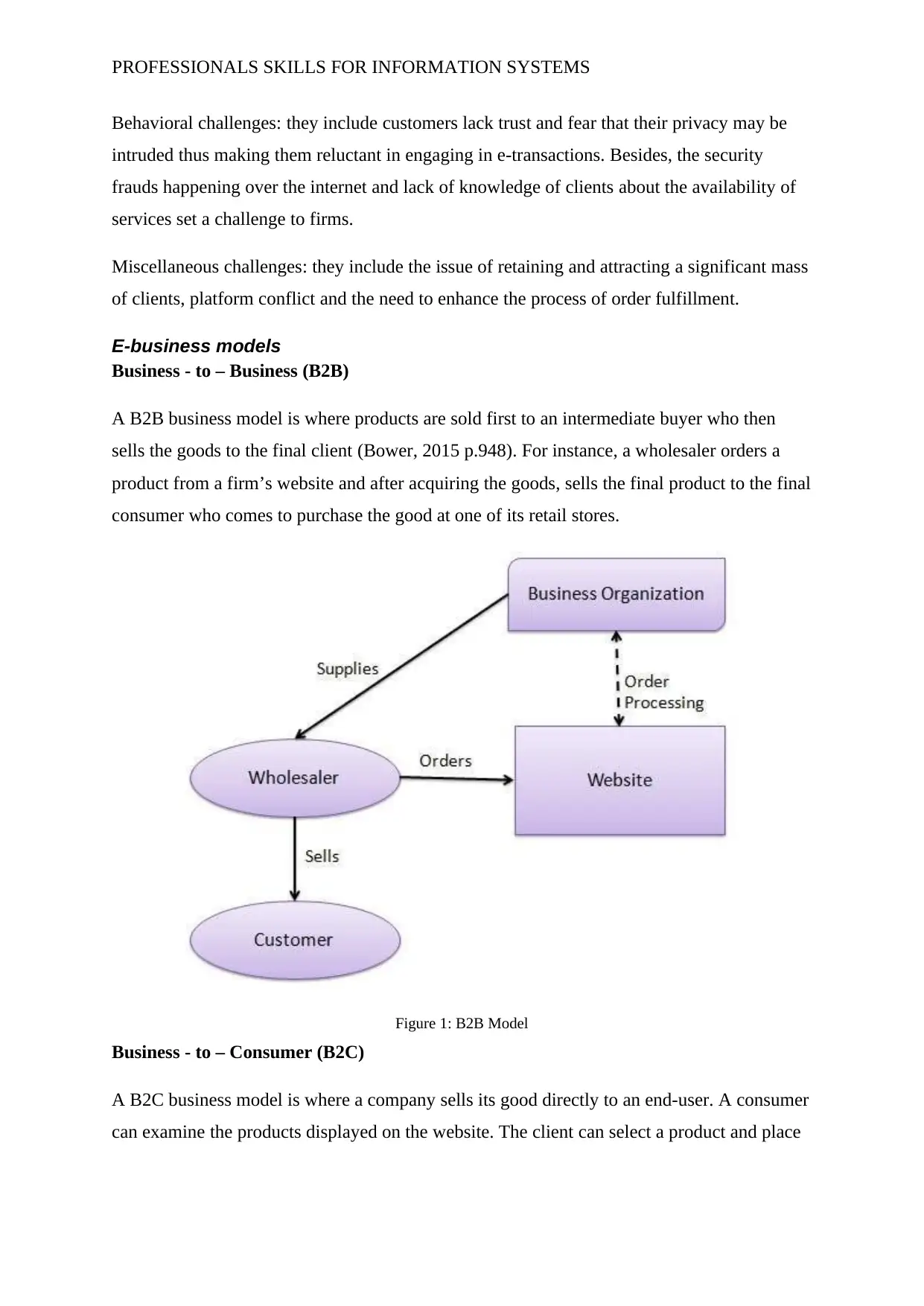
PROFESSIONALS SKILLS FOR INFORMATION SYSTEMS
Behavioral challenges: they include customers lack trust and fear that their privacy may be
intruded thus making them reluctant in engaging in e-transactions. Besides, the security
frauds happening over the internet and lack of knowledge of clients about the availability of
services set a challenge to firms.
Miscellaneous challenges: they include the issue of retaining and attracting a significant mass
of clients, platform conflict and the need to enhance the process of order fulfillment.
E-business models
Business - to – Business (B2B)
A B2B business model is where products are sold first to an intermediate buyer who then
sells the goods to the final client (Bower, 2015 p.948). For instance, a wholesaler orders a
product from a firm’s website and after acquiring the goods, sells the final product to the final
consumer who comes to purchase the good at one of its retail stores.
Figure 1: B2B Model
Business - to – Consumer (B2C)
A B2C business model is where a company sells its good directly to an end-user. A consumer
can examine the products displayed on the website. The client can select a product and place
Behavioral challenges: they include customers lack trust and fear that their privacy may be
intruded thus making them reluctant in engaging in e-transactions. Besides, the security
frauds happening over the internet and lack of knowledge of clients about the availability of
services set a challenge to firms.
Miscellaneous challenges: they include the issue of retaining and attracting a significant mass
of clients, platform conflict and the need to enhance the process of order fulfillment.
E-business models
Business - to – Business (B2B)
A B2B business model is where products are sold first to an intermediate buyer who then
sells the goods to the final client (Bower, 2015 p.948). For instance, a wholesaler orders a
product from a firm’s website and after acquiring the goods, sells the final product to the final
consumer who comes to purchase the good at one of its retail stores.
Figure 1: B2B Model
Business - to – Consumer (B2C)
A B2C business model is where a company sells its good directly to an end-user. A consumer
can examine the products displayed on the website. The client can select a product and place
Paraphrase This Document
Need a fresh take? Get an instant paraphrase of this document with our AI Paraphraser
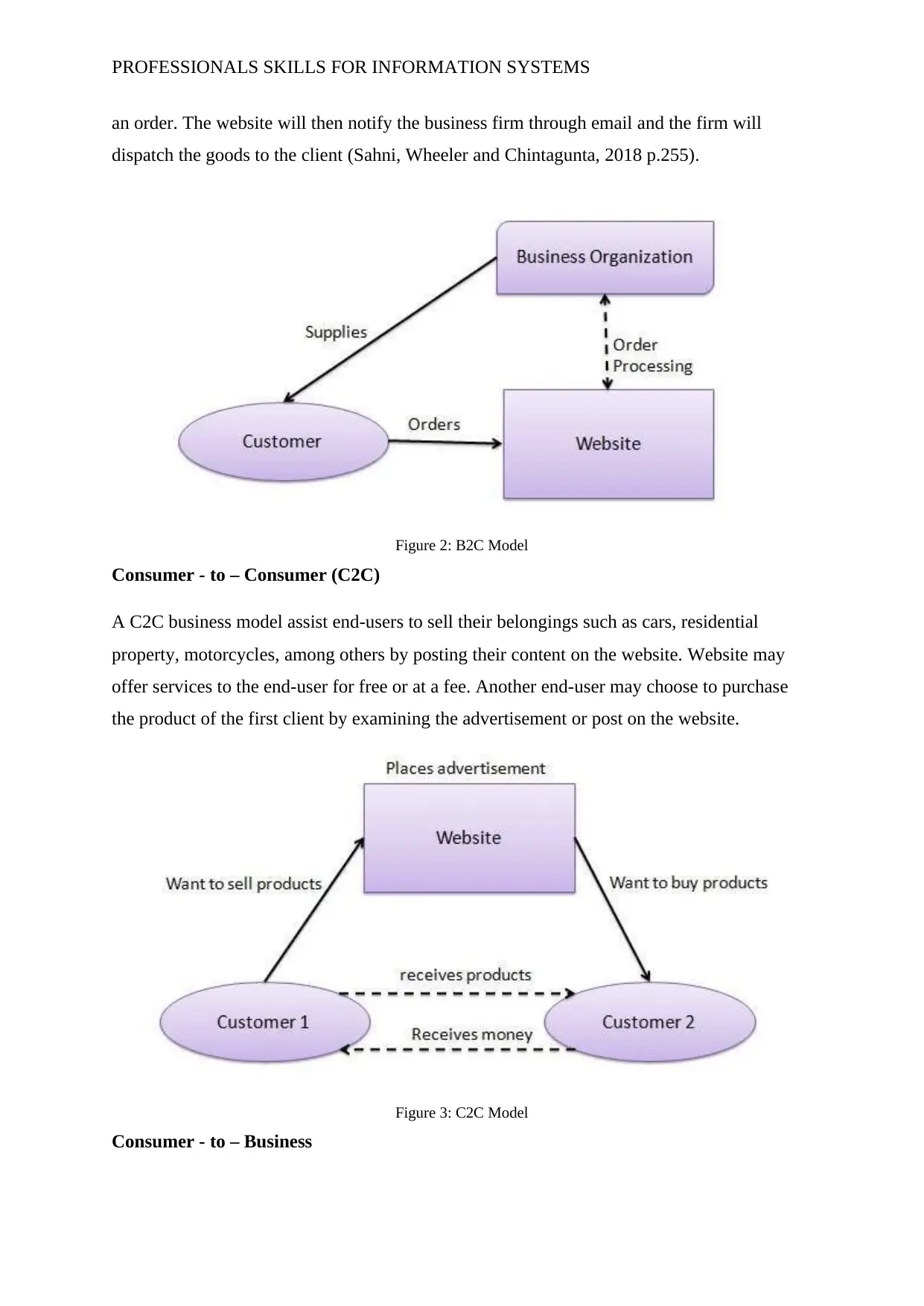
PROFESSIONALS SKILLS FOR INFORMATION SYSTEMS
an order. The website will then notify the business firm through email and the firm will
dispatch the goods to the client (Sahni, Wheeler and Chintagunta, 2018 p.255).
Figure 2: B2C Model
Consumer - to – Consumer (C2C)
A C2C business model assist end-users to sell their belongings such as cars, residential
property, motorcycles, among others by posting their content on the website. Website may
offer services to the end-user for free or at a fee. Another end-user may choose to purchase
the product of the first client by examining the advertisement or post on the website.
Figure 3: C2C Model
Consumer - to – Business
an order. The website will then notify the business firm through email and the firm will
dispatch the goods to the client (Sahni, Wheeler and Chintagunta, 2018 p.255).
Figure 2: B2C Model
Consumer - to – Consumer (C2C)
A C2C business model assist end-users to sell their belongings such as cars, residential
property, motorcycles, among others by posting their content on the website. Website may
offer services to the end-user for free or at a fee. Another end-user may choose to purchase
the product of the first client by examining the advertisement or post on the website.
Figure 3: C2C Model
Consumer - to – Business
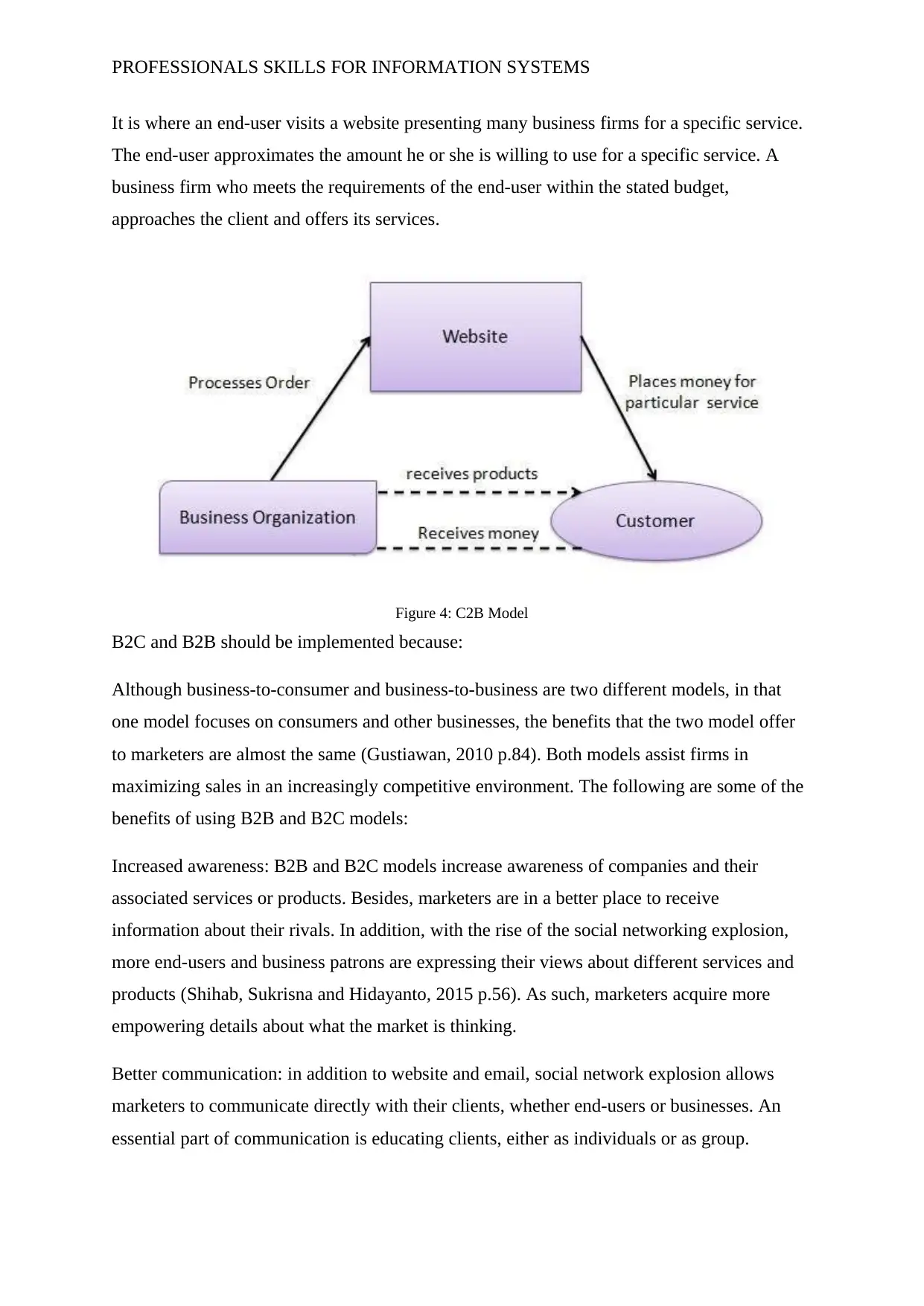
PROFESSIONALS SKILLS FOR INFORMATION SYSTEMS
It is where an end-user visits a website presenting many business firms for a specific service.
The end-user approximates the amount he or she is willing to use for a specific service. A
business firm who meets the requirements of the end-user within the stated budget,
approaches the client and offers its services.
Figure 4: C2B Model
B2C and B2B should be implemented because:
Although business-to-consumer and business-to-business are two different models, in that
one model focuses on consumers and other businesses, the benefits that the two model offer
to marketers are almost the same (Gustiawan, 2010 p.84). Both models assist firms in
maximizing sales in an increasingly competitive environment. The following are some of the
benefits of using B2B and B2C models:
Increased awareness: B2B and B2C models increase awareness of companies and their
associated services or products. Besides, marketers are in a better place to receive
information about their rivals. In addition, with the rise of the social networking explosion,
more end-users and business patrons are expressing their views about different services and
products (Shihab, Sukrisna and Hidayanto, 2015 p.56). As such, marketers acquire more
empowering details about what the market is thinking.
Better communication: in addition to website and email, social network explosion allows
marketers to communicate directly with their clients, whether end-users or businesses. An
essential part of communication is educating clients, either as individuals or as group.
It is where an end-user visits a website presenting many business firms for a specific service.
The end-user approximates the amount he or she is willing to use for a specific service. A
business firm who meets the requirements of the end-user within the stated budget,
approaches the client and offers its services.
Figure 4: C2B Model
B2C and B2B should be implemented because:
Although business-to-consumer and business-to-business are two different models, in that
one model focuses on consumers and other businesses, the benefits that the two model offer
to marketers are almost the same (Gustiawan, 2010 p.84). Both models assist firms in
maximizing sales in an increasingly competitive environment. The following are some of the
benefits of using B2B and B2C models:
Increased awareness: B2B and B2C models increase awareness of companies and their
associated services or products. Besides, marketers are in a better place to receive
information about their rivals. In addition, with the rise of the social networking explosion,
more end-users and business patrons are expressing their views about different services and
products (Shihab, Sukrisna and Hidayanto, 2015 p.56). As such, marketers acquire more
empowering details about what the market is thinking.
Better communication: in addition to website and email, social network explosion allows
marketers to communicate directly with their clients, whether end-users or businesses. An
essential part of communication is educating clients, either as individuals or as group.
⊘ This is a preview!⊘
Do you want full access?
Subscribe today to unlock all pages.

Trusted by 1+ million students worldwide
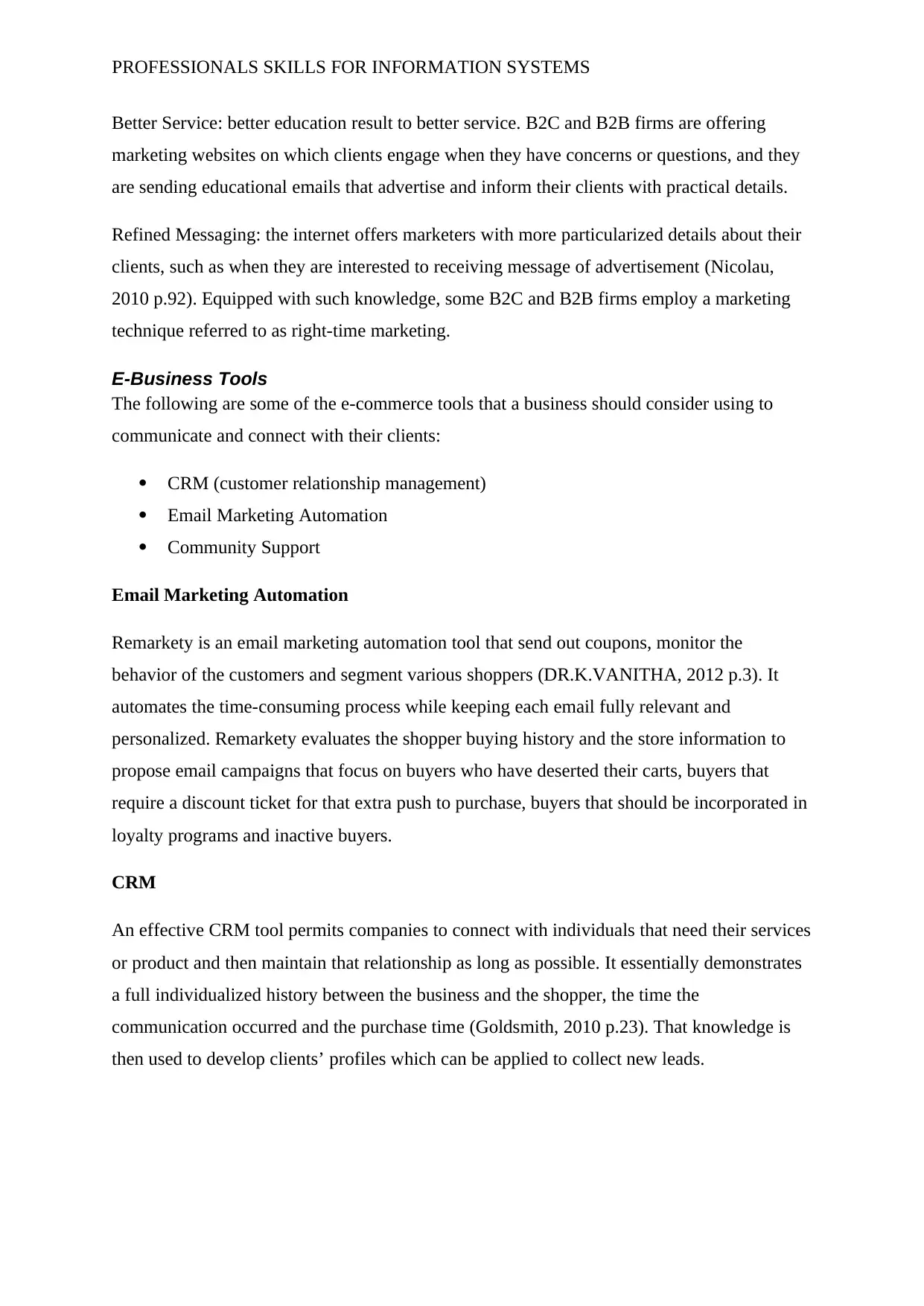
PROFESSIONALS SKILLS FOR INFORMATION SYSTEMS
Better Service: better education result to better service. B2C and B2B firms are offering
marketing websites on which clients engage when they have concerns or questions, and they
are sending educational emails that advertise and inform their clients with practical details.
Refined Messaging: the internet offers marketers with more particularized details about their
clients, such as when they are interested to receiving message of advertisement (Nicolau,
2010 p.92). Equipped with such knowledge, some B2C and B2B firms employ a marketing
technique referred to as right-time marketing.
E-Business Tools
The following are some of the e-commerce tools that a business should consider using to
communicate and connect with their clients:
CRM (customer relationship management)
Email Marketing Automation
Community Support
Email Marketing Automation
Remarkety is an email marketing automation tool that send out coupons, monitor the
behavior of the customers and segment various shoppers (DR.K.VANITHA, 2012 p.3). It
automates the time-consuming process while keeping each email fully relevant and
personalized. Remarkety evaluates the shopper buying history and the store information to
propose email campaigns that focus on buyers who have deserted their carts, buyers that
require a discount ticket for that extra push to purchase, buyers that should be incorporated in
loyalty programs and inactive buyers.
CRM
An effective CRM tool permits companies to connect with individuals that need their services
or product and then maintain that relationship as long as possible. It essentially demonstrates
a full individualized history between the business and the shopper, the time the
communication occurred and the purchase time (Goldsmith, 2010 p.23). That knowledge is
then used to develop clients’ profiles which can be applied to collect new leads.
Better Service: better education result to better service. B2C and B2B firms are offering
marketing websites on which clients engage when they have concerns or questions, and they
are sending educational emails that advertise and inform their clients with practical details.
Refined Messaging: the internet offers marketers with more particularized details about their
clients, such as when they are interested to receiving message of advertisement (Nicolau,
2010 p.92). Equipped with such knowledge, some B2C and B2B firms employ a marketing
technique referred to as right-time marketing.
E-Business Tools
The following are some of the e-commerce tools that a business should consider using to
communicate and connect with their clients:
CRM (customer relationship management)
Email Marketing Automation
Community Support
Email Marketing Automation
Remarkety is an email marketing automation tool that send out coupons, monitor the
behavior of the customers and segment various shoppers (DR.K.VANITHA, 2012 p.3). It
automates the time-consuming process while keeping each email fully relevant and
personalized. Remarkety evaluates the shopper buying history and the store information to
propose email campaigns that focus on buyers who have deserted their carts, buyers that
require a discount ticket for that extra push to purchase, buyers that should be incorporated in
loyalty programs and inactive buyers.
CRM
An effective CRM tool permits companies to connect with individuals that need their services
or product and then maintain that relationship as long as possible. It essentially demonstrates
a full individualized history between the business and the shopper, the time the
communication occurred and the purchase time (Goldsmith, 2010 p.23). That knowledge is
then used to develop clients’ profiles which can be applied to collect new leads.
Paraphrase This Document
Need a fresh take? Get an instant paraphrase of this document with our AI Paraphraser
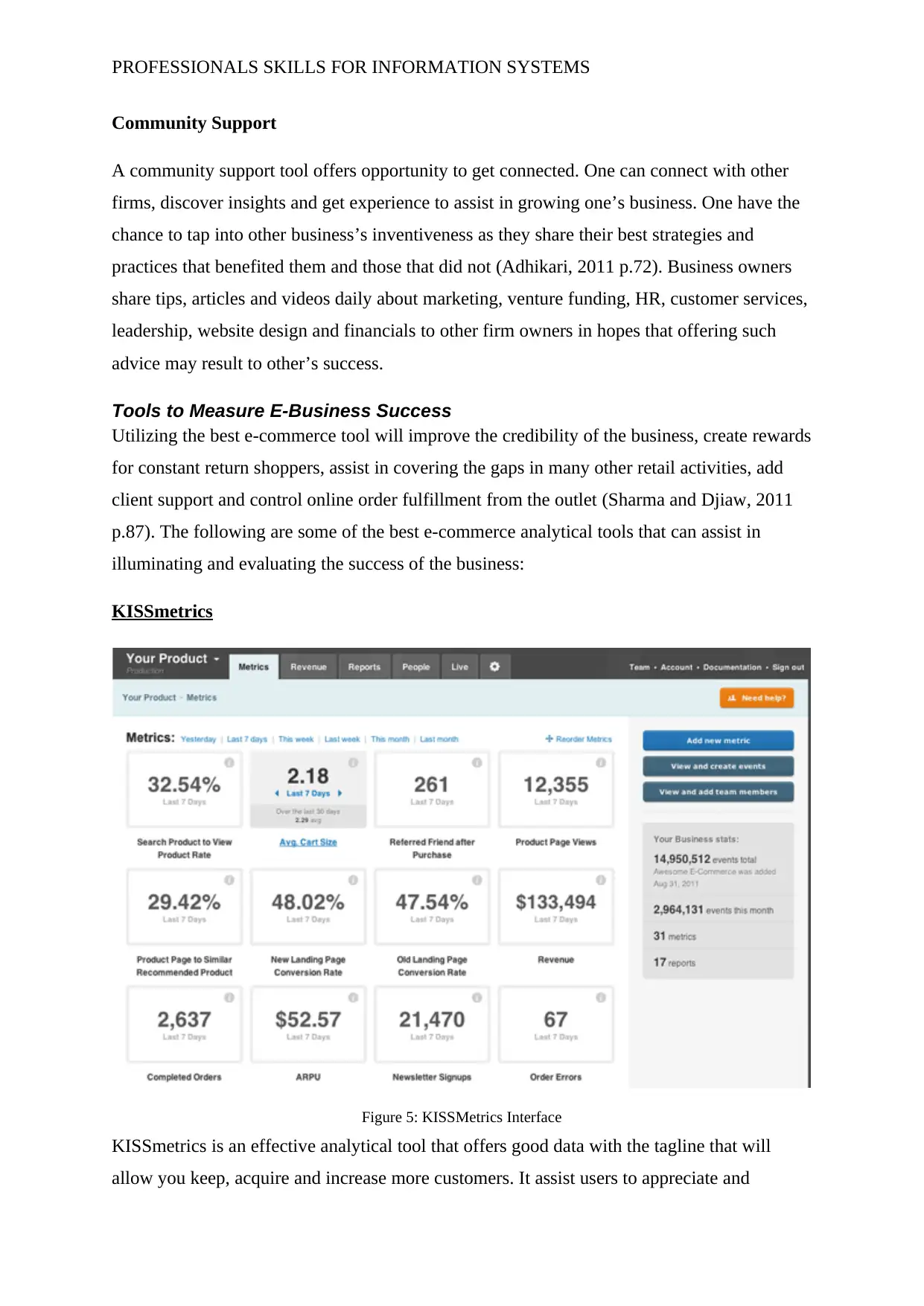
PROFESSIONALS SKILLS FOR INFORMATION SYSTEMS
Community Support
A community support tool offers opportunity to get connected. One can connect with other
firms, discover insights and get experience to assist in growing one’s business. One have the
chance to tap into other business’s inventiveness as they share their best strategies and
practices that benefited them and those that did not (Adhikari, 2011 p.72). Business owners
share tips, articles and videos daily about marketing, venture funding, HR, customer services,
leadership, website design and financials to other firm owners in hopes that offering such
advice may result to other’s success.
Tools to Measure E-Business Success
Utilizing the best e-commerce tool will improve the credibility of the business, create rewards
for constant return shoppers, assist in covering the gaps in many other retail activities, add
client support and control online order fulfillment from the outlet (Sharma and Djiaw, 2011
p.87). The following are some of the best e-commerce analytical tools that can assist in
illuminating and evaluating the success of the business:
KISSmetrics
Figure 5: KISSMetrics Interface
KISSmetrics is an effective analytical tool that offers good data with the tagline that will
allow you keep, acquire and increase more customers. It assist users to appreciate and
Community Support
A community support tool offers opportunity to get connected. One can connect with other
firms, discover insights and get experience to assist in growing one’s business. One have the
chance to tap into other business’s inventiveness as they share their best strategies and
practices that benefited them and those that did not (Adhikari, 2011 p.72). Business owners
share tips, articles and videos daily about marketing, venture funding, HR, customer services,
leadership, website design and financials to other firm owners in hopes that offering such
advice may result to other’s success.
Tools to Measure E-Business Success
Utilizing the best e-commerce tool will improve the credibility of the business, create rewards
for constant return shoppers, assist in covering the gaps in many other retail activities, add
client support and control online order fulfillment from the outlet (Sharma and Djiaw, 2011
p.87). The following are some of the best e-commerce analytical tools that can assist in
illuminating and evaluating the success of the business:
KISSmetrics
Figure 5: KISSMetrics Interface
KISSmetrics is an effective analytical tool that offers good data with the tagline that will
allow you keep, acquire and increase more customers. It assist users to appreciate and
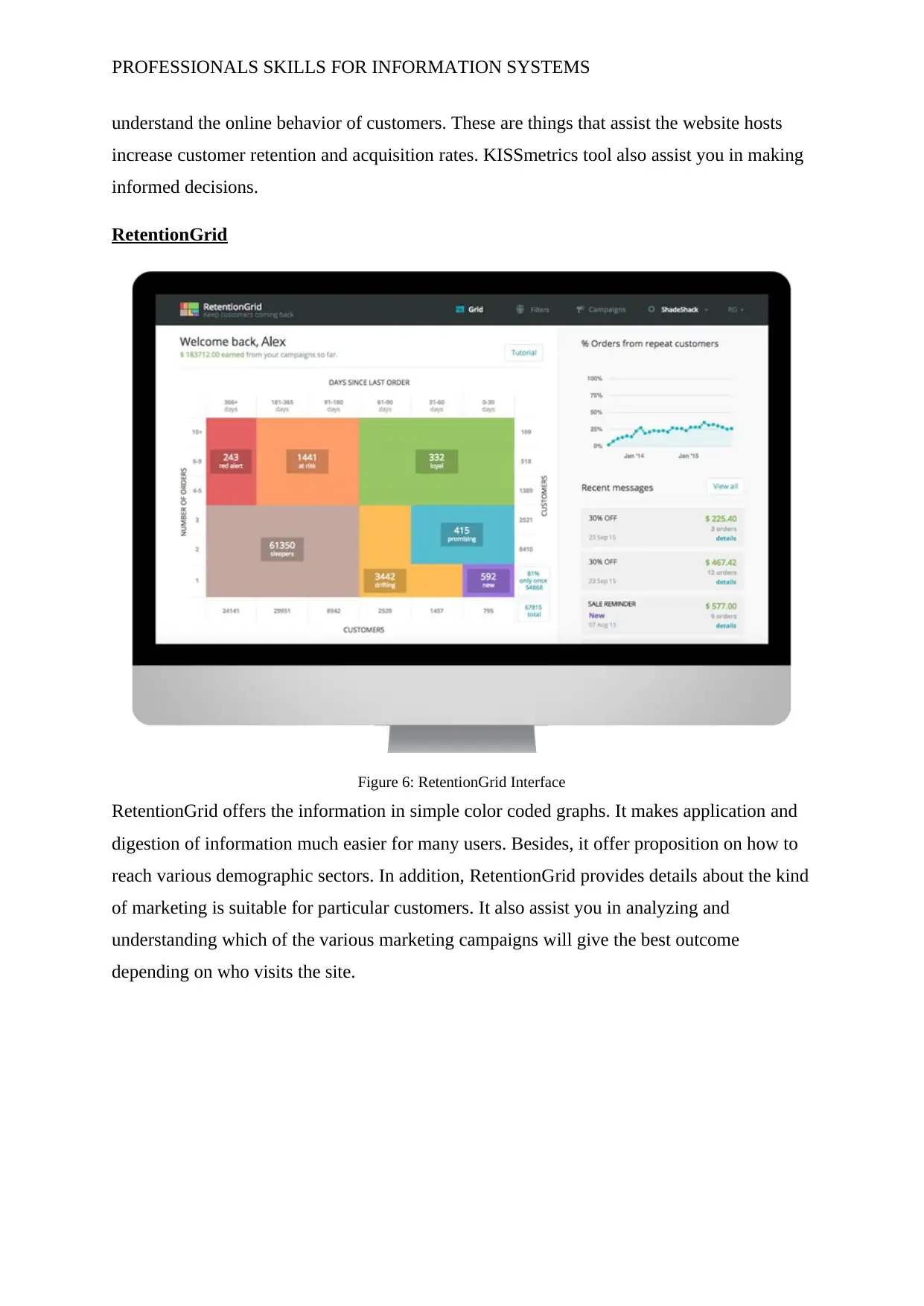
PROFESSIONALS SKILLS FOR INFORMATION SYSTEMS
understand the online behavior of customers. These are things that assist the website hosts
increase customer retention and acquisition rates. KISSmetrics tool also assist you in making
informed decisions.
RetentionGrid
Figure 6: RetentionGrid Interface
RetentionGrid offers the information in simple color coded graphs. It makes application and
digestion of information much easier for many users. Besides, it offer proposition on how to
reach various demographic sectors. In addition, RetentionGrid provides details about the kind
of marketing is suitable for particular customers. It also assist you in analyzing and
understanding which of the various marketing campaigns will give the best outcome
depending on who visits the site.
understand the online behavior of customers. These are things that assist the website hosts
increase customer retention and acquisition rates. KISSmetrics tool also assist you in making
informed decisions.
RetentionGrid
Figure 6: RetentionGrid Interface
RetentionGrid offers the information in simple color coded graphs. It makes application and
digestion of information much easier for many users. Besides, it offer proposition on how to
reach various demographic sectors. In addition, RetentionGrid provides details about the kind
of marketing is suitable for particular customers. It also assist you in analyzing and
understanding which of the various marketing campaigns will give the best outcome
depending on who visits the site.
⊘ This is a preview!⊘
Do you want full access?
Subscribe today to unlock all pages.

Trusted by 1+ million students worldwide
1 out of 29
Related Documents
Your All-in-One AI-Powered Toolkit for Academic Success.
+13062052269
info@desklib.com
Available 24*7 on WhatsApp / Email
![[object Object]](/_next/static/media/star-bottom.7253800d.svg)
Unlock your academic potential
Copyright © 2020–2025 A2Z Services. All Rights Reserved. Developed and managed by ZUCOL.



